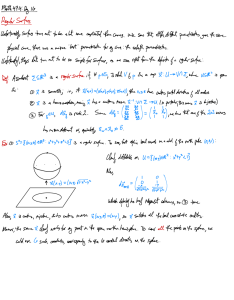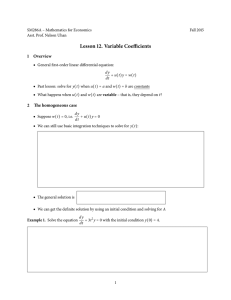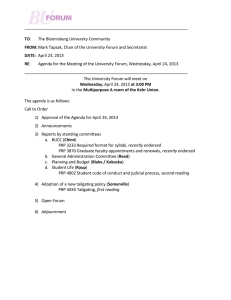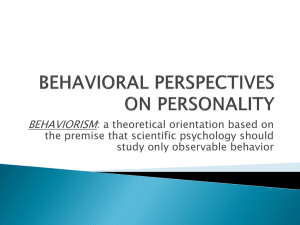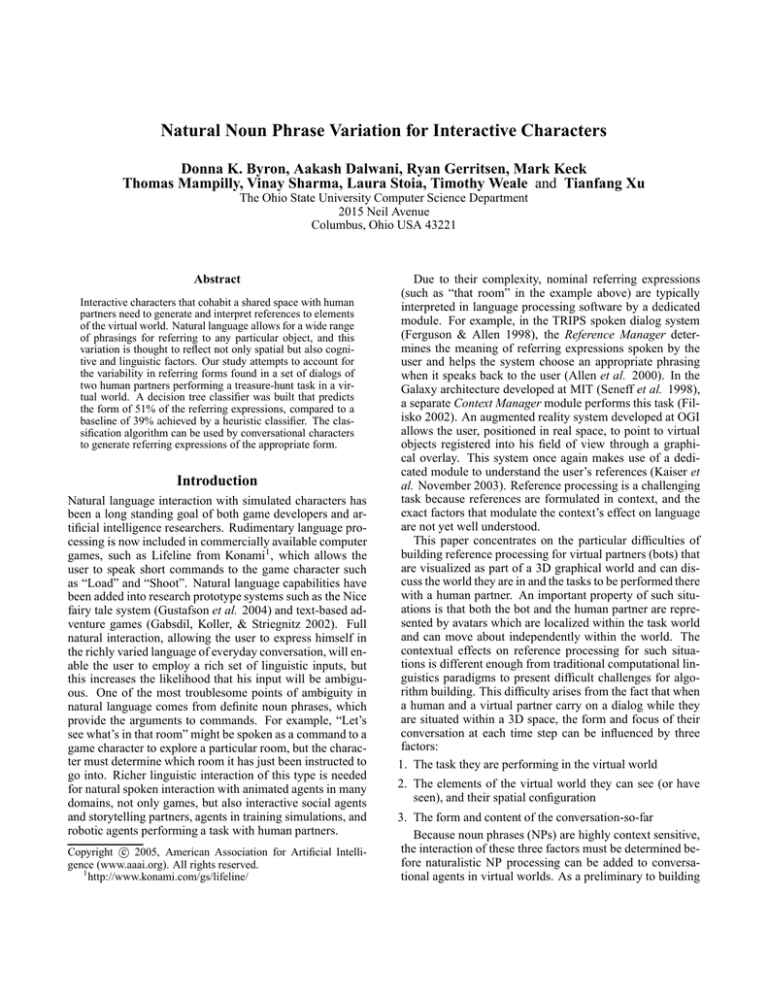
Natural Noun Phrase Variation for Interactive Characters
Donna K. Byron, Aakash Dalwani, Ryan Gerritsen, Mark Keck
Thomas Mampilly, Vinay Sharma, Laura Stoia, Timothy Weale and Tianfang Xu
The Ohio State University Computer Science Department
2015 Neil Avenue
Columbus, Ohio USA 43221
Abstract
Interactive characters that cohabit a shared space with human
partners need to generate and interpret references to elements
of the virtual world. Natural language allows for a wide range
of phrasings for referring to any particular object, and this
variation is thought to reflect not only spatial but also cognitive and linguistic factors. Our study attempts to account for
the variability in referring forms found in a set of dialogs of
two human partners performing a treasure-hunt task in a virtual world. A decision tree classifier was built that predicts
the form of 51% of the referring expressions, compared to a
baseline of 39% achieved by a heuristic classifier. The classification algorithm can be used by conversational characters
to generate referring expressions of the appropriate form.
Introduction
Natural language interaction with simulated characters has
been a long standing goal of both game developers and artificial intelligence researchers. Rudimentary language processing is now included in commercially available computer
games, such as Lifeline from Konami1 , which allows the
user to speak short commands to the game character such
as “Load” and “Shoot”. Natural language capabilities have
been added into research prototype systems such as the Nice
fairy tale system (Gustafson et al. 2004) and text-based adventure games (Gabsdil, Koller, & Striegnitz 2002). Full
natural interaction, allowing the user to express himself in
the richly varied language of everyday conversation, will enable the user to employ a rich set of linguistic inputs, but
this increases the likelihood that his input will be ambiguous. One of the most troublesome points of ambiguity in
natural language comes from definite noun phrases, which
provide the arguments to commands. For example, “Let’s
see what’s in that room” might be spoken as a command to a
game character to explore a particular room, but the character must determine which room it has just been instructed to
go into. Richer linguistic interaction of this type is needed
for natural spoken interaction with animated agents in many
domains, not only games, but also interactive social agents
and storytelling partners, agents in training simulations, and
robotic agents performing a task with human partners.
c 2005, American Association for Artificial IntelliCopyright gence (www.aaai.org). All rights reserved.
1
http://www.konami.com/gs/lifeline/
Due to their complexity, nominal referring expressions
(such as “that room” in the example above) are typically
interpreted in language processing software by a dedicated
module. For example, in the TRIPS spoken dialog system
(Ferguson & Allen 1998), the Reference Manager determines the meaning of referring expressions spoken by the
user and helps the system choose an appropriate phrasing
when it speaks back to the user (Allen et al. 2000). In the
Galaxy architecture developed at MIT (Seneff et al. 1998),
a separate Context Manager module performs this task (Filisko 2002). An augmented reality system developed at OGI
allows the user, positioned in real space, to point to virtual
objects registered into his field of view through a graphical overlay. This system once again makes use of a dedicated module to understand the user’s references (Kaiser et
al. November 2003). Reference processing is a challenging
task because references are formulated in context, and the
exact factors that modulate the context’s effect on language
are not yet well understood.
This paper concentrates on the particular difficulties of
building reference processing for virtual partners (bots) that
are visualized as part of a 3D graphical world and can discuss the world they are in and the tasks to be performed there
with a human partner. An important property of such situations is that both the bot and the human partner are represented by avatars which are localized within the task world
and can move about independently within the world. The
contextual effects on reference processing for such situations is different enough from traditional computational linguistics paradigms to present difficult challenges for algorithm building. This difficulty arises from the fact that when
a human and a virtual partner carry on a dialog while they
are situated within a 3D space, the form and focus of their
conversation at each time step can be influenced by three
factors:
1. The task they are performing in the virtual world
2. The elements of the virtual world they can see (or have
seen), and their spatial configuration
3. The form and content of the conversation-so-far
Because noun phrases (NPs) are highly context sensitive,
the interaction of these three factors must be determined before naturalistic NP processing can be added to conversational agents in virtual worlds. As a preliminary to building
reference processing, this paper examines how speakers in
3D dialog utilize different forms of referring expressions to
describe objects in their world. The goal is to discover regularities in the properties of the objects described and the
linguistic variation employed by human speakers. Any such
regularities can be utilized in bots for both reference understanding software and also to produce appropriate, natural
sounding NPs by virtual characters with natural language
generation capabilities.
Background
When a speaker refers to a particular entity in the world, a
variety of different linguistic forms might be used for the referring expression. For example, a particular building can
be called “my house” (a description), “42 Main Street” (a
name), “that eyesore” (a demonstrative description) or “it”
(a pronoun), depending on the situation and the person being addressed. Although these different forms can all refer
to the same referent, at a specific point in a discourse, the
speaker is not completely at liberty to employ any alternative at all. Providing too much or too little information is
perceived as uncooperative (Grice 1975). Psycholinguistic
studies indicate that using the wrong form at the wrong time
can make a sentence confusing or even incomprehensible
(Garnham 2001).
As an engineering decision, a conversational bot might be
designed to only understand and produce particular forms,
for example, a common strategy is to assign every object
in the world a unique designator that must be used for that
item (as in example (1)). This strategy has multiple disadvantages. Requiring the human user to speak in an unnatural
fashion will force him to concentrate on formulating his sentences properly and distract him from attending to the task
at hand. When the same item is repeated in a discourse, it
is more natural to use a reduced form, as the second line
of example (2) demonstrates. If the bot produces an inappropriate form, such as in the fourth sentence of example
(1) when the bot repeats “the control room” rather than a
reduced form, psycholinguistic studies indicate that this is
likely to confuse the human partner (Chambers et al. 2002).
Also, it is awkward to teach the human player the correct
names for objects in the world, especially for objects that do
not naturally take on names, such as staircases, hairbrushes,
or corners of rooms. For such objects, the most desirable
strategy is to let the user refer to them with a natural phrasing of his own choosing, and for the bot to work out what
those words mean. Of course, 50 years of AI research has
demonstrated that this is not a simple task.
(1)
Conversation using only rigid designators
Human: We need to go back to the control
room and find the tactical officer
Bot:
Where was the control room?
Human: The control room is on the second
level near the stairs
Bot:
Right, let’s go to the control room
(2)
Conversation using NP variation
Human: We need to go back to the control
room and see if the tactical officer is
there now
Bot:
Where was that?
Human: It is upstairs just by the staircase
Bot:
Right, let’s go
Choosing the correct forms seems to involve a complex interdependency between properties of the speaker and
hearer and properties of the referent. This background section reviews prior work that clarifies which properties should
be taken into account. In the experiments described below,
we will put these claims to the test on situated dialog data.
Table 1: The Givenness Hierarchy (for Definite NPs)
Status
in
uniquely
focus > activated > familiar > identifiable
NP Form it/them this/that
they
this N
(PRP) (CDP/DP/
CDEM)
that N
the N
DEM
DEF
NPs can be phrased using either definite (e.g. the house,
my house) or indefinite forms (e.g. a house). Using a definite
expression signals that the speaker assumes that the object is
already known to the hearer, or easily inferable from what he
knows (Roberts 2003; Prince 1981). In the remainder of this
paper, we will restrict our focus to the variety of forms of
definite referring expressions. There are many forms of definite expression, so the high-level split of definite/indefinite
is not sufficient to choose a phrasing for a referring expression. The following terminlogy will be employed for definite expression types throughout this paper:
• Descriptive Definite (DEF): A common noun head, e.g.
house, plus a definite or possessive determiner, e.g.
the/my, or optional quantifier, e.g. the two buttons, as well
as modifiers.
• Demonstrative Description: The determiner this, that,
these, or those plus a descriptive head, e.g. house to
produce e.g. those houses. We will distinguish Close
Demonstrative Descriptions (CDEM) which use the determiners this and these from unmarked Demonstrative
Descriptions (DEM) with the determiners that and those
(Lyons 1977).
• Demonstrative Pronouns: The pronoun this, that, these,
those on their own with no common noun head. Again,
we distinguish between the close-marked ones (CDP) and
unmarked ones (DP).
• Personal Pronoun (PRP): Reduced forms with no common noun head such as he/she/them/it.
This leaves us with a set of 6 labels (PRP, CDP, DP,
CDEM, DEM, DEF) to distinguish definite NP forms. What
controls a speaker’s choice among these forms at a particular moment in time? Theoretical work such as the Givenness
Hierarchy, shown in Table 1 (Gundel, Hedberg, & Zacharski
1993) (henceforth GH) claims that each different NP form
signals the speaker’s assumption about the cognitive status
of a referent with the type(s) of referring expression that conventionally signal that status. The GH states that DEF signals uniquely identifiable, which means that the addressee
can attach a unique entity to the referring expression after
hearing the full sentence, whether or not he had previous
knowledge of that entity. This category is distinguished from
familiar, in which the addressee is expected to have prior
knowledge of the item being mentioned. Activated status,
used for DEM, CDEM, and CDP requires that the referent be
already in the addressee’s short term memory, having been
evoked by either the discourse or the setting.
What evidence can be used to decide if one’s conversational partner has prior knowledge of an item? (Clark &
Marshall 1981) call this mutual knowledge, and define the
following types of mutual knowledge:
Physical copresence:
Current: An item that the partners are simultaneously
attending to
Prior: An item seen before, that is memorable
Potential: An item not seen yet, that is locatable
Linguistic copresence: An item that was discussed before
and that is memorable.
Finally, referents of PRPs are claimed to have in Focus
status. The GH model defines focus as the: “partiallyordered subset of activated entities that are likely to be continued as topics of subsequent utterances”[pg. 279]. Computational models often use surface linguistic clues to estimate which item will be the topic of a subsequent utterance.
The grammatical role of each NP in a sentence is a commonly used surface clue. In English, there is a high probability that the top-level arguments of the verb will appear in
focus in the next sentence. In the sentence “Bruce put those
things next to the table”, Bruce is in subject position, and
those things is the direct object, and the relative focus ordering on these items would be Bruce > T hoseT hings >
T able. In addition to surface order properties, other parameters such as how many times a particular item has been mentioned in the discourse can be used to estimate topicality, and
these features have been found to be very useful for matching PRPs to their referents (see (Mitkov 2002) for a recent
survey). Focus is acknowledged in the literature to be controlled by a variety of factors beyond linguistic clues, but
these are most commonly used since they can be reliably
computed.
The task that the partners are performing also places
the focus on items important to the task (Grosz 1977;
Kasper, Davis, & Roberts 1999). In our treasure-hunt domain, once the partners decide that they will perform a particular objective next, such as finding a helmet, that item
remains focused until the task objective shifts. In addition,
the items in the scene, especially items that the speaker is
currently looking at, are also likely to be continued as topic.
Taken together, these claims about the factors that modulate a speaker’s choice of NP form seem to converge around
Figure 1: One player’s view when he says: “the things the
table we need to move those things around”
three significant dimensions:
Spatial The arrangement in 3D space of the speaker, hearer,
and object. The important distinction in this dimension
can be called COPRESENCE: the item is now perceptually accessible to both the speaker and hearer at the point
when the NP is spoken, or it was COPRESENT earlier.
Cognitive Whether the addressee already knows about the
object, or if it is brand new to him. If it is already known,
to what extent is his attention focused on the object. The
relevant categories here are: FOCUS, ACTIVATED, FAMILIAR.
LINGUISTIC Has the object been mentioned before, how
recently, and in what argument position.
Situated Interaction in Quake
The data studied here was collected as part of a pilot project
underway in the SLATE lab at OSU2 . In this study, two human partners were established as ‘players’ in a first-person
graphical world, rendered by the QuakeII game engine3.
The partners are in the virtual world, where they collaborate
on a treasure hunt task working from printed instructions
that show pictures of several items they must either manipulate or find and move to a new location. Both players have
the same capabilities for performing the task. The partners
communicate with each other through headset-mounted microphones, and an audio recording of their dialog was saved
and later transcribed. In addition, each player’s movement
and activity in the virtual world was recorded to video tape.
The QuakeII game engine allows the two partners to move
about in the world independently and manipulate objects. As
he moves about, each player sees a first-person view of the
virtual world. When both players position themselves so that
they have an unobstructed view of each other, they can observe the avatar representing the other player and its actions
in the virtual world. Therefore, the two players can stand in
the same virtual setting and discuss what they see or what
2
3
http://slate.cis.ohio-state.edu
available as open source from www.id.com
88-4:
89-1:
89-2:
90-1:
90-2:
90-3:
91-1:
92-1:
92-2:
92-3:
92-4:
93-1:
94-1:
A:
B:
B:
A:
A:
A:
B:
A:
A:
A:
A:
B:
A:
cause I’m gonna drop it
yeah
there it is
yeah
so that needs to go there
and then we just need a box to appear
is it one of the metal boxes
yeah
one of the metal the cubicle boxes with the
I guess they’re metal
the brown ones brownish grey
is is it one of the items that we can pick up
no
Figure 2: Actual treasure hunt dialog fragment
scripts represent 70 minutes of elapsed time and contain a
total of 10,547 words, with 987 definite NPs (Table 2).
NP Form
Frequency
Lexical NPs
The N (DEF)
383
This N (CDEM)
90
That N (DEM)
68
Pronouns
This (CDP)
59
That (DP)
130
It/them/they (PRP)
257
Total
987
Table 2: Number of test cases in the dataset
they plan to do, and can observe their partner’s movements
in the world, as shown in Figure . When they are not together in the world, they tend to inform each other of their
position. As a result, when the players move about the world
independently, they can still mentally estimate which items
in the world their partner knows about and which items he is
not yet familiar with.
The human partners use a variety of NP forms to refer to
objects in the virtual world. Figure 2 shows a small excerpt,
in which a particular item is referred to with it in 88-4 and
that in 90-2, and the metal box they are searching for goes
from a box to it. It should be noted that this human-human
data represents an extreme case of unconstrained language,
which is likely to differ from how humans would speak to
a bot for the same task (Jönsson & Dahlbäck 1988; Oviatt
1985; Doran et al. 2001). However, this data provides a rich
testbed for understanding NP forms, and is useful especially
for developing algorithms for language generation software
in automated characters.
Looking at the variety of expressions found in this corpus,
the question that naturally arises is:
1. How do the spatial and cognitive properties of entities in
the world correlate to the different referring forms? If a
bot were trying to participate in this conversation, how
should it choose whether to call the box it or the box, for
instance.
2. Given a referring expression to interpret, can a bot accurately infer the spatial and cognitive properties of the object being referred to, and use this information to interpret
the expression?
Experiments
These experiments were undertaken to discover the extent
to which variation in the NP forms found in the treasure
hunt dialogs could be accounted for using the properties described above in Section 2. This section compares a heuristically constructed classifier, using hand-constructed rules to
apply the claims from previous authors, to a classifier induced using machine learning. The test data used in these
experiments comes from transcribing three pilot humanhuman task sessions involving 6 distinct speakers. The tran-
Each noun phrase N Pi listed in Table 2 was assigned one
of the six labels (PRP, CDP, DP, CDEM, DEM, DEF), and
was annotated with the following attributes:
TASKFOCUS The object that has been established as the
currently active goal of the task. Referents outside of the
task world are labeled MOOT.
LINGFOCUS The highest ranked item mentioned in the
sentence before the sentence containing N Pi (using
grammatical role rankings) is the linguistic focus at the
start of N Pi . If N Pi mentions that same item, it is marked
with LINGFOCUS=Y, otherwise LINGFOCUS=N
LINGCOPRES The item has been mentioned in the dialog
at some point before N Pi is spoken. LINGFOCUS will
necessarily be a subset of LINGCOPRES.
PHYSCOPRES Using Clark and Marshall’s terms, each
item in the world is labeled according to its perceptual
accessibility. Possible values are:
MOOT = the item is un-see-able (ex. generic concepts,
facts, etc.)
NO = the item has never been seen
PRIOR = the item was seen before but is not in view now
CURRENT = the players can see the object now
POTENTIAL = the item might be seen if the players
look around at their current position
Baseline Classifier
Based on the background material described above in Section 2, we expect the following properties to hold for the
NPs in this corpus. We constructed a hand-crafted classifier
that used these rules to label the test cases:
PRP Is expected to be used for items with linguisticallyestablished focus or task focus
CDP, CDEM Are expected to be used for items in the scene
but not in focus
DP Should correlate with high-order items that cannot have
physical copresence (e.g. “let’s do that”), or items that
the speaker wishes to draw the hearer’s attention to (e.g.
“what’s THAT?”).
DEM are not in the scene but known and discussed previously
88-4:
89-1:
89-2:
90-1:
90-2:
90-3:
91-1:
92-1:
92-2:
92-3:
92-4:
93-1:
94-1:
A:
B:
B:
A:
A:
A:
B:
A:
A:
A:
A:
B:
A:
cause I’m gonna drop it
yeah
there it is
yeah
so IT needs to go there
and then we just need a box to appear
is it one of the metal boxes
yeah
one of the metal the cubicle boxes with the
I guess THE BOXES are metal
the brown ones brownish grey
is is it one of the items that we can pick up
no
Figure 3: Dialog fragment using the Decision Tree rules to
choose the form of NPs. UPPERCASE NPs in 90-2 and 923 differ from the original dialog.
DEF items not in the current setting, and either seen before
but not discussed, or unseen
Therefore, the logic for classifying each test item is:
case LINGFOCUS
Y: form=PRP;
N: case TASKFOCUS
Y: form=PRP;
N: case PHYSCOPRES
MOOT: form=DP;
PRIOR: case LINGCOPRES
Y: form=DEM;
N: form=DEF;
CURRENT: form=oneof(CDP|CDEM);
POTENTIAL: form=DP;
NO: form=DEF;
These criteria correctly accounted for 39% of the distribution of forms in this corpus. Table 3 shows the performance
on each NP form for the baseline classifier using the standard metrics of Precision (the ratio of items from each category that received the right label) and Recall (the number of
items assigned each label divided by the number that should
have been assigned that label).
NP Form
DEF
CDEM/CP
DEM
DP
PRP
Total
Baseline
Decision Tree
# Right Prec. Recall Right Prec. Recall
383
57 .15
.73 299 .78
.53
150
77 .51
.40
0
0
0
68
5 .07
.05
4 .06
.25
130
25 .19
.29
46 .35
.53
257 224 .87
.42 160 .62
.51
987 388 .39
.39 509 .51
.51
Table 3: Comparison of Algorithm performance
taskfocus = no
|
physcopres = no
|
|
lingfocus = no: DEF
|
|
lingfocus = yes: PRP
|
physcopres = curr: DEF
|
physcopres = potential: DEF
|
physcopres = moot
|
|
lingcopres = no: DEF
|
|
lingcopres = yes: DP
|
physcopres = prior: DEF
taskfocus = yes
|
physcopres = no: PRP
|
physcopres = curr
|
|
lingcopres = no: DEM
|
|
lingcopres = yes: PRP
|
physcopres = potential
|
|
lingfocus = no: DEF
|
|
lingfocus = yes: PRP
|
physcopres = moot
|
|
lingfocus = no: DP
|
|
lingfocus = yes: PRP
|
physcopres = prior
|
|
lingfocus = no: DEF
|
|
lingfocus = yes: PRP
taskfocus = moot: DEM
Figure 4: Decision Tree for labeling NPFORM
this test data. The best-performing decision tree it induced
is shown in Figure 4.
Decision tree classification accuracy on the test data are
also shown in Table 3 in the columns marked “. Note that
these results were obtained on the test data used to build
the classifier. Performance on unseen data was only slightly
lower (the decision tree correctly labeled 50% of cases in 3fold cross-validation). No rules were generated in the decision tree for either of the close-marked forms THIS or THIS
NP. This implies that the feature set developed thus far does
not capture the right dimensions that are important determiners for using this form. Adding more fine-grained attentional
features such as spatial proximity and gesture would probably improve this category.
These rules can be used to generate referring expressions
of the appropriate form. Figure 3 shows the dialog fragment from Figure 2 as it would appear with the definite noun
phrases replaced by the form determined by the decision
tree. Note that, because of the overlapping usage conditions
for some forms, there are cases where our algorithm does
not produce the same form as the human speakers did, yet
the form it does generate is still felicitous. For example, our
algorithm produces it in utterance 90-2 rather than that. In
future work, as more data is available, we plan to evaluate
the generated output by asking human judges whether the
wording produced by our algorithm is acceptable in context.
Summary
Decision Tree Algorithm
Since there are multiple factors in the criteria for NP form,
it seems appropriate to use machine learning to attempt to
improve the hand-crafted classifier. We built a decision tree
classifier using the WEKA toolkit (Witten & Frank 2000)
to learn the decision process to assign NPFORM labels to
This study makes a first attempt at establishing the rules for
wording NPs appropriate to the context in situated dialog.
The rules can be used to either understand language produced by people, or for a bot working in a virtual world to
produce the full variety of forms in the right circumstances.
The current classifier predicts the correct label for only 51%
of our test cases, so obviously more work is needed to develop more sensitivity in the algorithm. However, we feel
this represents an important first stride toward building detailed specifications of noun phrase processing for agents
working in rich, multi-modal situations such as computer
games and training simulations.
Acknowledgments
The authors would like to acknowledge our gratitude to Brad
Mellen and David Menninger for their work creating the
QuakeII data collection environment, and Whitney GeggHarrison for help transcribing the recordings.
References
Allen, J.; Byron, D.; Dzikovska, M.; Ferguson, G.; Galescu, L.;
and Stent, A. 2000. An architecture for a generic dialogue shell.
Natural Language Engineering 6(3&4):213–228.
Chambers, C.; Tanenhaus, M.; Eberhard, K.; Carlson, G.; and
Filip, H. 2002. Circumscribing referential domains in real time
language comprehension. Journal of Memory and Language
47:30–49.
Clark, H. H., and Marshall, C. R. 1981. Definite reference and
mutual knowledge. In Joshi, A. K.; Webber, B. L.; and Sag, I.,
eds., Elements of Discourse Understanding. Cambridge University Press. 10–62.
Doran, C.; J.Aberdeen; Damianos, L.; and L.Hirshman.
2001. Comparing several aspects of human-human and humancomputer dialogues. In Proceedings of the 2nd Sigdial workshop
on discourse and dialog.
Ferguson, G., and Allen, J. F. 1998. TRIPS: An intelligent integrated problem-solving assistant. In Proceedings of the National
Conference on Artificial Intelligence (AAAI ’98).
Filisko, E. A. 2002. A context resolution server for the GALAXY
conversational system. Master’s thesis, Massachusetts Institute of
Technology Department of Electrical Engineering and Computer
Science.
Gabsdil, M.; Koller, A.; and Striegnitz, K. 2002. Natural Language and Inference in a Computer Game. In Proceedings of
the 19th International Conference on Computational Linguistics
(COLING02).
Garnham, A., ed. 2001. Mental models and the interpretation of
anaphora. Psychology Press.
Grice, H. P. 1975. Logic and conversation. In Cole, P., and Morgan, J., eds., Syntax and Semantics, 41–58. New York: Academic
Press.
Grosz, B. J.; Jones, K. S.; and Webber, B. L., eds. 1986. Readings
in Natural Language Processing. Morgan Kaufmann.
Grosz, B. J. 1977. The representation and use of focus in a
system for understanding dialogs. In Proceedings of the International Joint Conference on Artificial Intelligence (IJCAI ’77),
67–76. Reprinted in (Grosz, Jones, & Webber 1986).
Gundel, J. K.; Hedberg, N.; and Zacharski, R. 1993. Cognitive
status and the form of referring expressions in discourse. Language 69(2):274–307.
Gustafson, J.; Bell, L.; Boye, J.; Lindstrom, A.; and Wire, M.
2004. The nice fairy-tale game system. In Proceedings of the 5th
Sigdial Workshop on Discourse and Dialog.
Jönsson, A., and Dahlbäck, N. 1988. Talking to a computer is
not like talking to your best friend. In Proceedings of the first
Scandinavian Conference on Artificial Intelligence, 297–307.
Kaiser, E.; Olwal, A.; McGee, D.; Benko, H.; Corradini, A.; Li,
X.; Cohen, P.; and Feiner, S. November 2003. Mutual disambiguation of 3d multimodal interaction in augmented and virtual
reality. In Proceedings of the 5th international conference on
Multimodal interfaces (ICMI 2003).
Kasper, R. T.; Davis, P. C.; and Roberts, C. 1999. An integrated
approach to reference and presupposition resolution. In The Relation of Discourse/Dialogue Structure and Reference: Workshop
at the 37th Annual Meeting of the Association for Computational
Linguistics (ACL-99), 1–10.
Lyons, J. 1977. Semantics. Cambridge University Press.
Mitkov, R. 2002. Anaphora Resolution. Longman.
Oviatt, S. L. 1985. Predicting spoken disfluencies during humancomputer interaction. Computer Speech and Language 9(1):19–
35.
Prince, E. F. 1981. Toward a taxonomy of given-new information.
In Cole., ed., Radical Pragmatics. Academic Press. 223–255.
Roberts, C. 2003. Uniqueness in definite noun phrases. Linguistics and Philosophy 26(3):287–350.
Seneff, S.; Hurley, E.; Lau, R.; Pao, C.; Schmid, P.; and Zue, V.
1998. GALAXY-II: A reference architecture for conversational
system development. In Proceedings of ICSLP-98.
Witten, I. H., and Frank, E. 2000. Data Mining: Practical machine learning tools with Java implementations. San Francisco:
Morgan Kaufmann.


